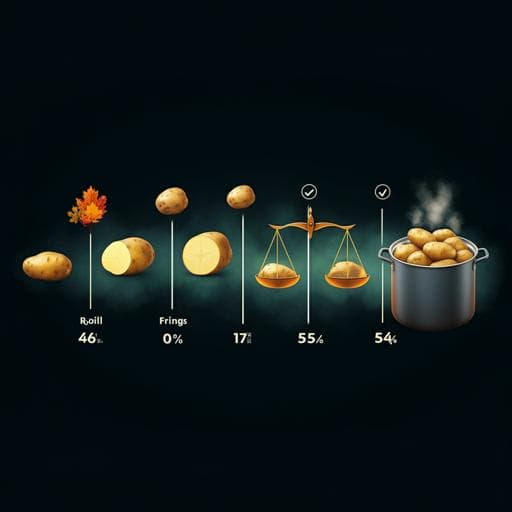
Food Science and Technology
Nutritional-environmental trade-offs in potato storage and processing for a sustainable healthy diet
A. Payne, E. M. Kwofie, et al.
This study by Aubin Payne, Ebenezer M. Kwofie, Prince Agyemang, and Jamie I. Baum uncovers critical insights into micronutrient retention in potatoes, exploring how storage and cooking methods impact both nutrition and the environment. Discover how your kitchen practices can lead to a healthier diet and a more sustainable planet.
~3 min • Beginner • English
Introduction
The study addresses how household storage and processing of potatoes influence micronutrient retention and environmental impacts, contributing to persistent micronutrient deficiencies and environmental burdens in the food system. Contextually, global malnutrition, rising noncommunicable diseases, and COVID-19-related increases in hunger underscore the need to optimize diets for both health and sustainability. While fortification and biofortification have helped, nutrient leakages occur along the food value chain, including at the consumer node where processing choices affect both nutrition and environmental impacts. The research objectives were: (1) to track changes in potato mineral profiles during typical household storage and processing from retail to consumption; (2) to quantify environmental impacts of each storage-processing combination via life cycle assessment (ReCiPe 2016); and (3) to identify optimal household strategies using TOPSIS under varying priorities for nutrition versus environmental sustainability, aligning with SDG 2 and SDG 12.
Literature Review
Prior work shows significant nutrient losses along value chains and during household processing. For common beans, large declines in minerals (up to 88%) were observed along value chain stages, with preprocessing conditions accelerating polyphenol degradation. Postharvest handling, storage, and marketing contributed major losses and economic impacts in legume value chains. Environmental LCAs (e.g., Parajuli et al.) identified the consumer node as a hotspot (~47% of total impact), yet did not differentiate household storage and processing. Consumer trends indicate increasing interest in sustainability, suggesting behavioral shifts can reduce environmental footprints. Potato-specific studies report spatial mineral heterogeneity within tubers (e.g., P, Mg, K higher centrally; Na, Fe higher distally) and differences between peel versus flesh; peeling and cooking can reduce phytochemicals and minerals. These findings motivate examining household storage effects (including sprouting and solanine concerns) and processing choices on both nutrition and environmental outcomes.
Methodology
Design: A full factorial experiment evaluated three storage conditions, two storage durations, and three processing methods using Russet potatoes purchased from retail (Walmart). Storage conditions: cupboard (17.5–22.4 °C; 32.7–48% RH), refrigerator (−1.8–0.89 °C; 37.5–66.1% RH), and ideal (7.2–11.1 °C; 85.0–92.4% RH). Storage times: 2 weeks (±3 days) and 5 weeks (±3 days). Processing pathways: boiling (water at 100 °C, 15 min), baking (204 °C oven, 17 min after preheat), frying (vegetable oil; 149 °C for 7 min then 204 °C for 2 min). Temperature and humidity were logged (Kestrel Drop sensors). Before storage, fresh samples were also processed. Samples were cut into standardized cross sections for each method. Nutrient analysis: University of Arkansas Central Analytical Lab assessed fat (AOCS AM 5-04 ether extraction), calories (Parr 6200 bomb calorimetry), and minerals (ICP-OES after nitric acid/hydrogen peroxide digestion). Dry matter was measured (110 °C, 12 h). Additional experiments evaluated inter- and intra-tuber mineral variability and surface vs inner flesh composition; sprout removal occurred before analysis. Environmental LCA: Gate-to-gate from consumer purchase to consumption was modeled in OpenLCA v1.11.0 using Ecoinvent v3.7.1 and ReCiPe 2016 Midpoint and Endpoint methods, normalized to World 2010 (H/H). Functional unit: 1 kg of processed potato ready to eat. System boundary excluded production, pre-retail transport, and primary packaging; included storage energy/water and cooking energy; biowaste from peeling estimated at 10%. Refrigerator allocation used BLS data: potatoes estimated to occupy ~0.16% of fridge space; energy use assumed 1.1–1.5 kWh/day depending on setting. Cooking energy was estimated via heat transfer calculations: boiling total ~3690 kJ (~1.02 kWh), frying ~8784 kJ (~2.44 kWh), baking ~3888 kJ (~1.08 kWh). Impact categories included global warming, ecotoxicities, eutrophication, land use, ozone depletion, particulate matter, resource scarcity, etc. Uncertainty: Monte Carlo (1000 runs) with OpenLCA pedigree-based lognormal uncertainties yielded coefficients of variation ~6–7% for characterized indicators; sensitivity analysis varied cooking temperature and oil use by ±10%. Decision modeling: TOPSIS ranked storage-processing alternatives under three weighting schemes for environmental sustainability vs nutrition: equal (0.5/0.5), environment-prioritized (0.8/0.2), and nutrition-prioritized (0.2/0.8). Criteria included endpoint damages (human health, ecosystems, resources), mineral loss/gain (10 macro/micronutrients), and calories. Practical equivalence threshold set at ±1% in performance score.
Key Findings
- Storage duration effects on nutrition: Storing potatoes for 5 weeks (±3 days) and then processing increased nutrient losses relative to 2 weeks (±3 days) by 33.5% (boiling), 40.3% (baking), and 15.0% (frying).
- Environmental impacts of longer storage: Averaged across conditions, 5-week storage and processing caused ~2.2 ± 0.7 times more endpoint damage (human health, ecosystems, resources) than 2-week storage; ~53.6 ± 10.3 times more damage than freshly purchased and processed potatoes.
- Optimal pathway: Storing in a cupboard and boiling (BL-CP) offered the best combined outcome (high nutrient retention with low environmental impacts), supporting a sustainable healthy diet.
- Mass changes during processing: For 2-week storage, frying and baking reduced mass by ~40–45% and 27–33%, respectively; for 5-week storage, frying and baking losses increased to ~55–63% and 35–51%. Boiling increased mass by ~2–6% (2 weeks) and ~8–22% (5 weeks), likely due to water absorption.
- Mineral retention patterns: Baking under ideal storage (BK-ID) after 5 weeks provided the highest overall mineral retention at consumption (except Na) and ~26% mineral increase vs raw-unstored. For frying, FR-CP (5 weeks) had highest retention for Ca (~+16%), K (~−5% loss), Fe (~+7%), and Mg (~−3% loss) vs RW-US; FR-FG (2 weeks) maximized P (~+33%), Na (~−40% loss), and Mg (~+16%). Largest losses across scenarios were for Na and K.
- Example LCA midpoint results (2 weeks): BL-FG associated with freshwater and marine ecotoxicities of ~0.53 and 0.64 kg 1,4-DCB eq, and global warming of 27.1 kg CO2-eq per kg processed. BL-US had the lowest impacts: ~9.16E-02 kg 1,4-DCB (freshwater), 9.57E-02 kg 1,4-DCB (marine), and 3.12 kg CO2-eq.
- Example LCA midpoint results (5 weeks): FR-CP had the highest impacts with ~5.67 kg 1,4-DCB (freshwater), 7.03 kg 1,4-DCB (marine), and 2.91E+02 kg CO2-eq per kg processed; impacts >10× BL-CP (2 weeks) across many categories.
- Endpoint damages: For 2-week BL-FG, damages were 2.73E-04 DALY (human health), 2.00E-06 species·yr (ecosystems), and $3.62 resource loss. For 5-week FR-CP, damages were 5.93E-04 DALY, 3.22E-06 species·yr, and $10.6. Processing after 5 weeks caused ~2.23× the damage of 2 weeks; FR-CP (5 weeks) caused ~64× (health), ~186× (ecosystems), and ~38× (resources) more damage than freshly purchased and processed potatoes, averaging ~96.5 ± 9.8 times more across endpoints.
- Consumer node as hotspot: Frying scenarios generally had higher impacts; refrigeration-linked boiling (BL-FG) also showed elevated impacts due to electricity and water use.
- Safety: Sprouting can increase solanine; green tissues and sprouts should be removed to avoid toxicity.
- TOPSIS trade-offs (2 weeks): When environmental sustainability was prioritized, BL-CP was optimal; when nutrition was prioritized, BL-FG was optimal; under equal weighting, BL-CP ranked at or near the top (practically equivalent alternatives within ±1% noted).
Discussion
The results confirm that household storage duration and processing choices substantially affect both micronutrient availability at consumption and environmental burdens. Longer storage increases environmental damages, largely via electricity for refrigeration and longer processing times, while nutrient outcomes are pathway-dependent and complicated by intrinsic mineral heterogeneity within tubers. Boiling after cupboard storage (BL-CP) minimized environmental harm and preserved minerals sufficiently to be the preferred strategy when sustainability is valued; conversely, boiling after refrigeration (BL-FG) may maximize certain minerals but at significantly higher environmental cost. Frying consistently amplified impacts, reinforcing the consumer node as an environmental hotspot. The TOPSIS analysis demonstrates how consumer priorities shift the optimal pathway, offering a practical decision framework for sustainable healthy diets. Findings underscore the importance of integrating household-level behaviors into nutrition education and sustainability interventions, and they illustrate how small changes in storage and cooking can reduce climate, toxicity, and resource impacts while maintaining nutrient intake. Safety considerations (e.g., solanine in sprouted/green potatoes) also influence household practices and should be incorporated into guidance.
Conclusion
This study introduces and applies a theoretical and methodological framework to jointly track nutrient leakage and environmental impacts for household potato storage and processing. Using a factorial design, LCA, and TOPSIS, it shows that extended storage substantially increases environmental damages and that the cupboard-plus-boiling (BL-CP) pathway achieves the best balance of nutrient retention and low impacts, supporting a sustainable healthy diet. The work translates into actionable consumer guidance and a decision-support approach adaptable to other commodities. Future research should expand to additional nutrients (vitamins and phytochemicals), broader product forms and varieties, diverse energy mixes and geographies, and full value-chain assessments including upstream stages and waste management to refine recommendations and quantify broader system-level benefits.
Limitations
- Scope limited to gate-to-gate (retail to consumption); upstream production, distribution, and packaging excluded.
- Limited number of tubers and subsamples; some observations (e.g., water absorption differences) lacked statistical power.
- Considerable intra- and inter-tuber mineral heterogeneity and surface vs flesh differences complicate generalization.
- LCA relies on assumptions for energy use (refrigerator allocation, cooking efficiencies) and databases (Ecoinvent); results are sensitive to local energy mixes.
- Only two storage durations (2 and 5 weeks) and three processing methods were examined; other common practices (e.g., microwaving, air frying) not assessed.
- Nutritional analysis focused on minerals, calories, and fat; vitamins and phytochemicals were not comprehensively evaluated.
- Uncertainty remains (CV ~6–7% across characterized indicators), though Monte Carlo analysis suggests reasonable precision.
Related Publications
Explore these studies to deepen your understanding of the subject.







